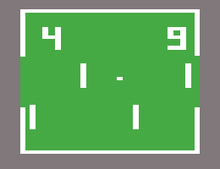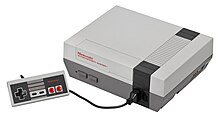Color TV-Game
Mitsubishi Electronics | |
| Manufacturer | Nintendo |
|---|---|
| Type | Dedicated home video game consoles |
| Generation | First |
| Release date | June 1, 1977 |
| Lifespan | 1977–1983[1] |
| Discontinued | 1983 |
| Units sold | 3 million[2] |
| Successor | Nintendo Entertainment System |
The Color TV-Game
History
 |
 |
Color TV-Game 6
|
Color TV-Game Racing 112
|
 |
 |
Color TV-Game Block Kuzushi
|
Computer TV-Game
|
By the late 1970s,
The Color TV-Game consoles were produced jointly by
The Color TV-Game 6 was launched on June 1, 1977.

One week later on June 8, Nintendo released the Color TV-Game 15.[15] It retailed for ¥15,000, roughly 50% more than the TV-Game 6. Essentially, the TV-Game 15 is an enhanced version of the TV-Game 6. Both consoles house the same fifteen games; however, only six are accessible on the TV-Game 6 without modification.[16] The TV-Game 15 has detachable controllers which are stored in a small compartment on the system. Nintendo produced a second model of the TV-Game 15 with a reddish-orange casing, which had a longer production run and are more common.[16] Sharp made a white-colored version that was renamed Color TV-Game XG-115.[16]
The third unit, the Color TV Game Racing 112, was published on June 8, 1978. It is significantly larger than the previous two units, with a larger shipping box to accompany it. Racing 112 was set to be released at ¥18,000, but was lowered to ¥12,000 to ensure competitiveness.[17] It was later reduced to ¥5,000. To prevent the machine from requiring a larger box, the wheel is detachable from the console.[17] The built-in game is a top-down racer similar to Speed Race, an arcade game released by Taito in 1974.[17] Variations include a smaller screen width and opponents that move faster, with all possible game combinations totaling to 112. The console also comes with two paddle controllers for multiplayer support.[17]
Color TV Game Block Kuzushi was released on April 23, 1979, at ¥13,500. The system was produced by Nintendo, allowing its name to be prominently displayed.[18] Block Kuzushi includes six variations of Breakout, an arcade game released in America by Atari. Nintendo released a clone of Breakout titled Block Fever for Japanese arcades in 1978.[19] Rival company Epoch released the TV Block console in Japan, which was successful and gave way to steady competition by other companies, including Nintendo.[13][18] The system's casing was designed by Mario creator Shigeru Miyamoto. It is one of his first video game projects after joining Nintendo in 1977.[18] The built-in games for Racing 112 and Block Kuzushi were designed by Takehiro Izushi.[20] Nintendo held competitions in department stores to promote the Block Kuzushi, where winners received a congratulatory note and a medal.[18]
The final console, the Computer TV Game, was released in 1980. Because dedicated consoles were decreasing in popularity, the Computer TV Game was only produced in limited quantities, making it extremely rare.
Legacy

The Color TV-Game series was very successful for Nintendo, and was a commercial hit. Nintendo sold one million units each of Color TV-Game 6 and Color TV-Game 15. One half million units each of Racing 112 and Block Kuzushi were sold.[2] Their success prompted Nintendo to continue pursuing the video game console market, leading to the creation of the Family Computer and the Nintendo Entertainment System.
Erik Voskuil, writing for his blog Before Mario, believes that part of the reason for the success of the Color TV-Game series was its low price point, far below the competition.
Nintendo has referenced the Color TV-Game systems and their built-in games in other franchises.
Notes
References
- ^ ISBN 978-0-07-223172-4.
- ^ ISBN 978-0-9669617-0-6.
Nintendo entered the home market in Japan with the dramatic unveiling of Color TV-Game 6, which played six versions of light tennis. It was followed by a more powerful sequel, Color TV-Game 15. A million units of each were sold. The engineering team also came up with systems that played a more complex game, called "Blockbuster," as well as a racing game. Half a million units of these were sold.
- USGamer. Archived from the originalon May 2, 2019. Retrieved December 9, 2019.
- ^ "Computer Othello for Arcade (1978)".
- ^ Plunkett, Luke (April 21, 2011). "Nintendo's First Arcade Games Were, Well, Pretty Sucky". Kotaku. Archived from the original on June 8, 2019. Retrieved May 8, 2020.
- OCLC 59416169.
- ^ a b c d e f g h Voskuil, Erik (April 9, 2011). "Nintendo Color TV-Game 6 (カラー テレビゲーム 6, 1977)". Before Mario. Archived from the original on October 27, 2019. Retrieved May 8, 2020.
- ^ Voskuil, Erik (March 15, 2011). "Nintendo Color TV Game Series (カラー テレビゲーム シリーズ, 1977-1979)". Before Mario. Archived from the original on October 24, 2019. Retrieved May 7, 2020.
- .
- ^ ISBN 978-4074176397.
- ^ Shea, Cam (10 March 2008). "Al Alcorn Interview". IGN. Archived from the original on 27 July 2017. Retrieved 13 October 2008.
- ^ "Magnavox Sues Firms Making Video Games, Charges Infringement". The Wall Street Journal. April 17, 1974.
- ^ ISBN 978-2918272151.
- ISBN 978-0-7190-4717-6.
- ^ "【任天堂「ファミコン」はこうして生まれた】第2回:電卓をあきらめてゲーム機ヘ". nikkeibp.co.jp (in Japanese). Nikkei Business Publications, Inc. September 30, 2008. Retrieved February 24, 2015.
こうして任天堂は1977年に、価格9800円の「カラーテレビゲーム 6」と、価格1万5000円の「カラーテレビゲーム 15」を売り出すことになる。
- ^ a b c Voskuil, Erik (January 22, 2012). "Nintendo Color TV-Game 15 (カラー テレビゲーム 15, 1977)". Before Mario. Archived from the original on October 31, 2019. Retrieved May 8, 2020.
- ^ a b c d Voskuil, Erik (May 28, 2011). "Nintendo Color TV Game Racing 112 (任天堂 カラー テレビゲーム レーシング 112, 1978)". Before Mario. Archived from the original on November 1, 2019. Retrieved May 8, 2020.
- ^ a b c d Voskuil, Erik (May 6, 2011). "Nintendo Color TV Game Block Kuzushi (任天堂 カラー テレビゲーム ブロック崩し, 1979)". Before Mario. Archived from the original on October 30, 2019. Retrieved May 8, 2020.
- ^ "Block Fever promotional sales flyer" (in Japanese). Nintendo. 1978. Archived from the original on December 7, 2019. Retrieved May 9, 2020.
- ^ "When Developers Did Everything". Iwata Asks (in Japanese). Nintendo. April 2010. Archived from the original on May 2, 2020. Retrieved May 8, 2020.
- ^ a b c d e Voskuil, Erik (February 20, 2011). "Nintendo Computer TV Game (コンピュータ TV ゲーム, 1980)". Before Mario. Archived from the original on November 1, 2019. Retrieved May 7, 2020.
- ^ S. Zavia, Matías (February 15, 2016). "Color TV-Game 6, la consola olvidada que Nintendo fabricó diez años antes de lanzar la NES". Gizmodo Espanol (in Spanish). Archived from the original on April 21, 2019. Retrieved May 9, 2020.
- ^ "Historical Data: Consolidated Sales Transition by Region" (xlsx). Nintendo. April 27, 2017. Archived from the original on October 26, 2017. Retrieved April 27, 2017.
- ISBN 978-0486801490.
- ^ Plunkett, Luke (March 25, 2011). "Nintendo's First Console Is One You've Never Played". Kotaku. Archived from the original on April 20, 2019. Retrieved May 8, 2020.
- PC Magazine. Ziff Davis. Archived from the originalon May 8, 2020. Retrieved May 8, 2020.
- ^ a b Parish, Jeremy (April 21, 2014). "Alleyway Retrospective". YouTube. Archived from the original on May 9, 2020. Retrieved May 9, 2020.
- ISBN 9781456617080. Retrieved May 8, 2020.
- ^ Radulovic, Petrana (June 22, 2018). "Super Smash Bros. Ultimate: Everything we know". Polygon. Vox Media. Archived from the original on December 7, 2019. Retrieved May 8, 2020.
- Nintendo of America. Archived from the originalon February 26, 2021. Retrieved December 5, 2020. Retrieved December 4, 2020.
